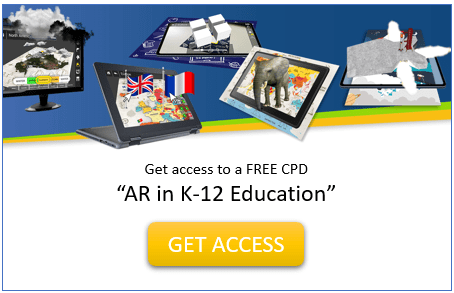
As K-12 educators, you are always looking for innovative ways to engage our students in learning, particularly in subjects like math, where students often struggle to find motivation and interest. One solution to this challenge is incorporating Augmented Reality (AR) into math lessons, making learning interactive, immersive, and enjoyable. In this article, we will explore various ways to use AR in teaching mathematical concepts such as geometry, number sense, and measurement, along with some fantastic AR tools for K-12 classrooms.
What is Augmented Reality and its Benefits in Education
Augmented Reality (AR) is a technology that overlays digital information onto the real world, enhancing our perception and interaction with our surroundings. By integrating digital content with the physical environment, AR can create immersive and engaging learning experiences for students.
Some benefits of using AR in education include:
- Increased engagement: AR makes learning more interactive and fun, capturing students’ attention and keeping them engaged in the lesson.
- Improved retention: Studies have shown that students retain information better when they learn through interactive experiences, such as AR.
- Enhanced collaboration: AR can foster teamwork and collaboration among students, as they work together to explore and understand complex concepts.
- Inclusive learning: AR can cater to different learning styles and abilities, offering a more inclusive learning environment.
- Real-world applications: AR allows students to see the real-world applications of the concepts they are learning, making the content more relevant and meaningful.
Geometry in Augmented Reality
Geometry is a fundamental branch of mathematics that deals with shapes, sizes, and the properties of space. Using AR in teaching geometry can help students visualize and explore geometrical concepts in an interactive and immersive manner. Here are some ways to use AR for teaching geometry:
3D Shape Exploration -> Students can use AR apps to create and explore 3D shapes, such as cubes, spheres, and pyramids, in real-world settings. They can interact with these shapes by rotating, scaling, and moving them to gain a better understanding of their properties and relationships.
Angle Measurement -> AR tools can help students measure angles in real-world objects, such as buildings, using virtual protractors. This hands-on approach allows students to see the practical applications of angles and their measurements in everyday life.
Geometric Transformations -> AR can enable students to visualize and apply geometric transformations, such as translations, rotations, and reflections, on virtual 3D objects. This interactive approach can help learners gain a deeper understanding of the underlying principles and rules of transformations.
Number Sense and Augmented Reality
Number sense is the ability to understand and manipulate numbers and their relationships. Developing strong number sense is crucial for building a solid foundation in mathematics. AR can be used to teach various aspects of number sense, including:
Counting and Cardinality -> AR games and activities can help young learners practice counting and understanding the concept of cardinality – the idea that the last number in a counting sequence represents the total quantity. For example, an AR app could display a group of virtual objects in the real world, and students would count them to determine the total amount.
Place Value -> AR tools can help students visualize and explore the concept of place value by representing numbers in different forms, such as base ten blocks, number lines, or expanded notation. This interactive approach can enhance students’ understanding of the relative values of digits in a number.
Operations and Number Relationships -> Students can use AR apps to practice basic operations, such as addition, subtraction, multiplication, and division, in an engaging and interactive manner. AR can also help students explore number relationships, such as odd and even numbers, factors, and multiples.
Measurement and Augmented Reality
Measurement is an essential skill in mathematics, with applications in various fields such as science, engineering, and everyday life. AR can be used to teach different types of measurement, including:
Length, Area, and Volume -> AR tools can help students measure the length, area, and volume of real-world objects by overlaying virtual rulers, grids, or other measuring tools onto the physical environment. This hands-on approach allows students to see the practical applications of measurement skills.
Time and Money -> AR apps can help students practice telling time using virtual clocks or explore the concept of money by interacting with virtual coins and bills. These interactive experiences can reinforce the importance of time and money management in daily life.
Conclusion
Incorporating Augmented Reality in K-12 math lessons can create engaging, immersive, and enjoyable learning experiences for students. By using AR to teach geometry, number sense, and measurement, educators can help students develop a solid foundation in mathematics and foster a lifelong love for learning. With the wide range of AR tools available, it’s easier than ever to integrate this innovative technology into your math curriculum and bring learning to life for your students.

